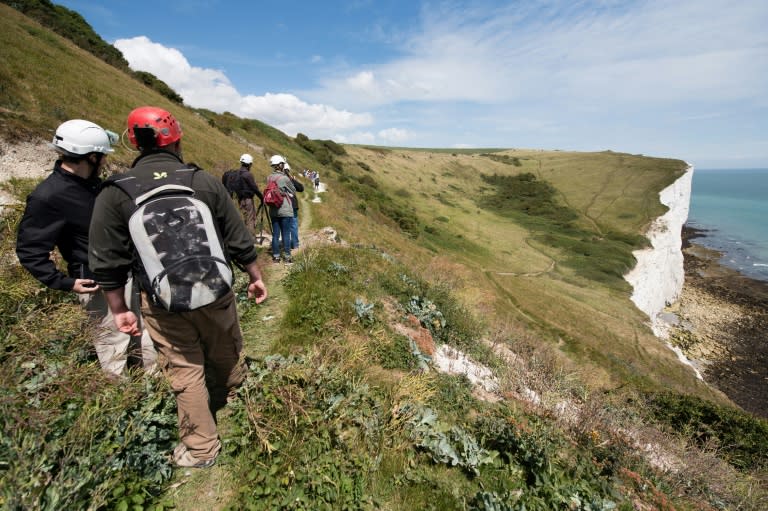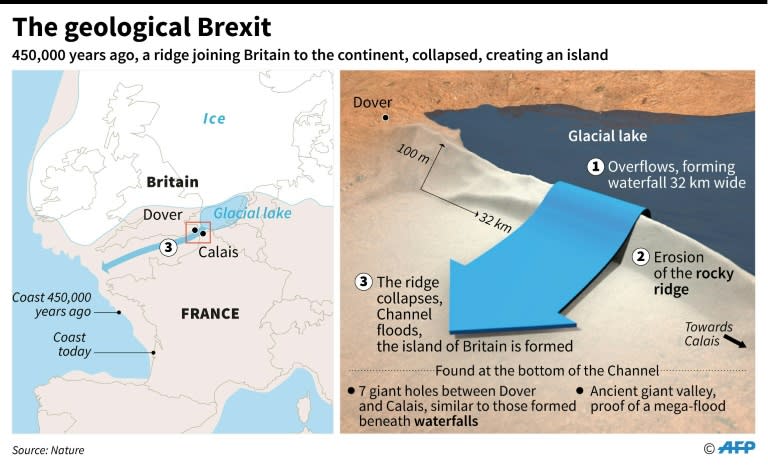Brexit 1.0: How Britain became an island
A giant waterfall tens of kilometres (miles) wide broke down a ridge which connected modern-day England to mainland Europe nearly half a million years ago, unleashing a mega-flood that gouged out the Channel and created the island of Britain, scientists said Tuesday. In an intricate piece of detective work, an international team of geologists said they had answered a puzzle that has gripped their profession for more than a century. Their sleuthing focuses on an ice age some 450,000 years ago, when much of the northern hemisphere was covered by a thick glacial slab and sea levels were far lower than they are today. The hypothetical picture of that epoch is of a Channel that was dry, cold and tundra-like. It rose to a ridge of chalky rock that joined Britain and mainland Europe at what is now the Strait of Dover. The scientists, writing in the journal Nature Communications, suggest that a mighty lake, fed by continental rivers, built up in the southern North Sea between the edge of the ice cap and this escarpment. The lake started to spill over the ridge, creating a waterfall some 32 kilometres (20 miles) wide and 100 metres (330 feet) high, and disgorging into a valley far below. The cascade eroded the crest of the dam, and eventually the wall cracked and collapsed, resulting in a tsunami that gouged out what is now the Channel. - Geological Brexit - The event had a huge impact on history, shaping early human settlement in Britain and the wars, trade, society and culture that followed. "The breaching of this land bridge between Dover and Calais was undeniably one of the most important events in British history, helping to shape our island nation's identity even today," said Sanjeev Gupta of Imperial College London, who co-authored the paper. "When the ice age ended and sea levels rose, flooding the valley floor for good, Britain lost its physical connection to the mainland," he said. "Without this dramatic breaching, Britain would still be part of Europe. This is Brexit 1.0 -- the Brexit nobody voted for." The idea that a glacial lake made the Channel was first aired a century ago, but struggled to make headway. The new study, though, finds fresh evidence to back the theory. In particular, it gives the nod to a marine geologist named Alec Smith, who in 1985 suggested the mega-flood was triggered by a waterfall -- an idea that was soon forgotten. The big clue comes from gigantic holes discovered in the bedrock of the Channel -- strange indentations up to several kilometres across and 100 metres (yards) deep, and filled with gravel and soft sand sediment. They were found by accident in the 1960s and 1970s, when engineers drilled test holes in the sea floor as part of exploratory work for the Channel Tunnel. In fact, the sediment was so loose that the engineers deemed that these holes were too dangerous to tunnel, and as a result the route of the Channel Tunnel was changed. - 'Plunge pools' - The scientists believe that these holes are so-called plunge pools -- chambers that are typically chiselled out in river beds beneath large waterfalls. Eventually, the holes can become so big that they cause the waterfall cliff to become unstable and collapse. Using new sonar scanning of the sea floor and a technique called seismic reflection, which uses pulses of energy to discern different rock formations, the team found that seven of these giant holes form a remarkable straight line, running from the ports of Calais to Dover -- the edge of the theorised ridge. They also saw evidence of an ancient giant valley on the Channel floor, the signs of a massive outpouring. The initial breach of the dam was followed by a second big event, possibly caused by a spillover of other, smaller lakes, the study suggests. But the timeline of the two events remains unclear, and they possibly occurred hundreds of thousands of years apart. Without this stroke of geological fate, Britain would have remained attached to the continent, rather like Denmark juts out into the sea from the European mainland, the scientists say.



